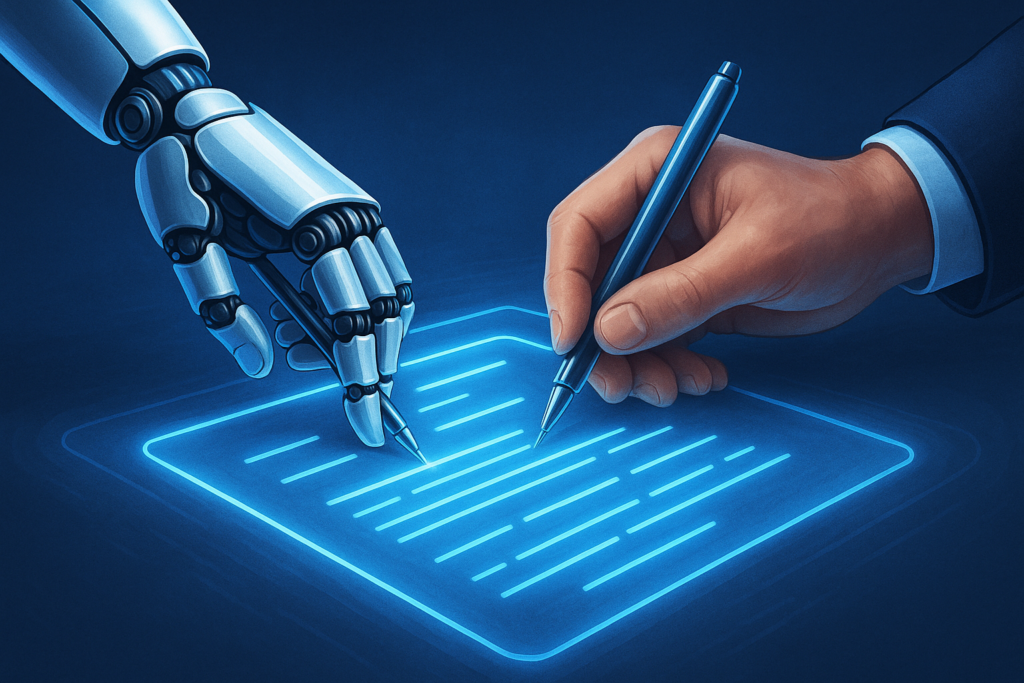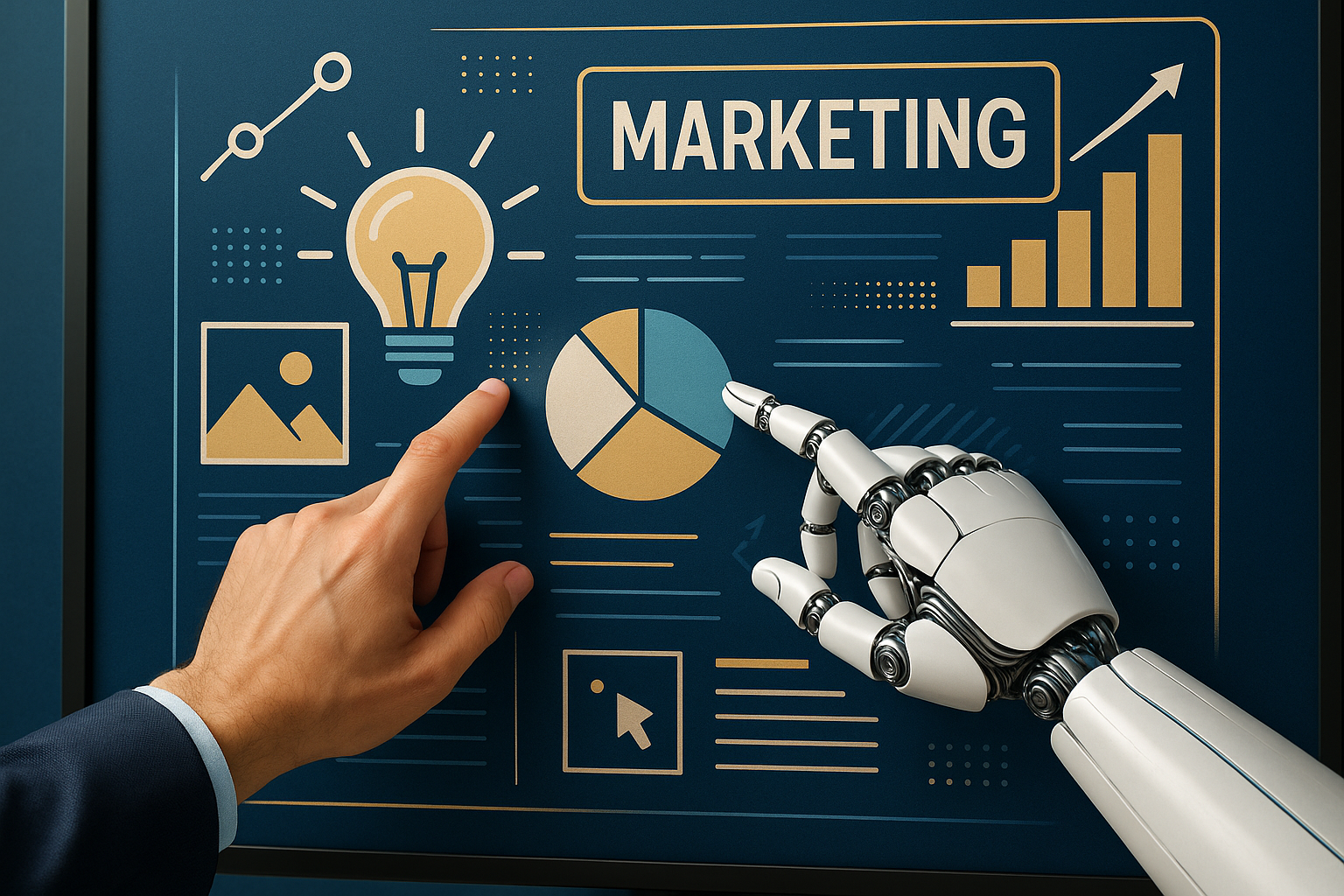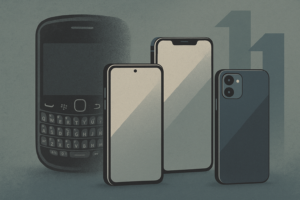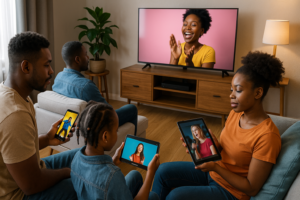The marketing world finds itself at a fascinating crossroads. Artificial intelligence can now generate campaign concepts in seconds, write compelling copy in minutes, and create visual content that would have taken designers hours. Yet the most memorable marketing campaigns—the ones that become cultural phenomena and drive genuine business impact—still emerge from distinctly human creativity. For business owners and marketing professionals, the critical question isn’t whether to choose AI or human creativity, but how to orchestrate them together. The businesses winning in this new landscape aren’t those picking sides but those discovering the perfect balance—leveraging AI’s speed and scale while preserving the strategic thinking, emotional intelligence, and authentic creativity that only humans provide.
Understanding What AI Actually Creates
Before we can balance AI and human creativity, we must honestly assess what AI does and doesn’t do well in creative contexts.
AI generates content through pattern recognition rather than genuine creative thinking. Large language models and image generators have analyzed millions of examples, learning statistical patterns about what works in various contexts. When you ask AI to create a marketing campaign, it synthesizes patterns it’s observed rather than thinking originally about your specific situation.
This distinction matters because AI excels at competent execution within established patterns but struggles with genuine innovation. It can produce professional-quality social media captions because it’s seen millions of them. It can generate product descriptions because the format is well-established. It can create advertising copy because conventional ad structures are thoroughly documented in its training data.
However, AI cannot think strategically about positioning, understand cultural moments, or generate truly original concepts that break from established patterns. The breakthrough campaign ideas, the clever subversions of expectations, the culturally resonant messages—these require human creativity drawing on life experience, cultural understanding, strategic business thinking, and genuine originality.
AI’s creative outputs tend toward the average because they’re based on statistical patterns in training data. The result typically resembles the most common approaches rather than the most distinctive ones. This produces competent but generic content lacking the memorable qualities that make marketing effective.
Consider AI-generated advertising concepts. They often include standard elements—lifestyle imagery, benefit-focused copy, clear calls-to-action—because these patterns appear frequently in successful ads. But the campaigns that become iconic typically violate conventions in ways AI wouldn’t suggest because they fall outside statistical norms.
AI lacks understanding of brand essence, competitive context, and strategic objectives unless explicitly instructed. It doesn’t know why your brand messaging should differ from competitors, what cultural conversations your campaign could enter, or how individual tactics serve broader strategic goals. These strategic considerations require human judgment informed by business understanding that AI doesn’t possess.
What Human Creativity Brings That AI Cannot
Human creativity offers distinct capabilities that remain beyond AI’s reach, even as the technology improves.
Strategic thinking and business judgment enable humans to understand why certain creative approaches serve business objectives while others don’t. Experienced marketers connect creative decisions to revenue goals, brand positioning, competitive dynamics, and market opportunities. They can evaluate whether creative concepts actually advance strategic priorities or merely look impressive without business impact.
AI can execute creative tactics but can’t determine which tactics serve strategy or how creative choices affect long-term brand building versus short-term conversions. These business judgments require experience and strategic thinking AI doesn’t possess.
Cultural awareness and contextual understanding allow human marketers to recognize cultural moments, understand audience sentiment, and anticipate how messages will be received in specific contexts. The ability to read cultural currents, understand timing, and craft messages that resonate with particular moments requires cultural immersion AI lacks.
Recent viral marketing campaigns typically succeed because human creators recognized cultural conversations and contributed relevant, timely perspectives. AI generates content based on training data that’s already months or years old, missing current cultural dynamics entirely.
Emotional intelligence and authentic connection enable humans to create content that genuinely resonates emotionally rather than simply mimicking emotional appeals. Understanding what truly moves people, what they care about deeply, and how to communicate authentically requires empathy and human experience.
The difference between marketing that manipulates and marketing that genuinely connects often comes down to authentic human understanding of audience emotions and needs. AI can simulate emotional appeals but lacks the genuine understanding that creates authentic emotional resonance.
Breakthrough innovation and risk-taking characterize human creativity at its best. The willingness to try unconventional approaches, challenge assumptions, and risk failure in pursuit of remarkable results drives innovation. AI gravitates toward proven patterns and safe approaches because unusual ideas fall outside its statistical training.
Revolutionary campaigns like Apple’s “Think Different,” Old Spice’s “The Man Your Man Could Smell Like,” or Dove’s “Real Beauty” emerged from human creativity willing to break from convention despite risks. AI wouldn’t generate these concepts because they deviate too far from established patterns.
Storytelling and narrative craft at the highest levels require understanding of dramatic structure, character development, thematic resonance, and emotional pacing that goes beyond pattern matching. Great marketing stories connect to universal human experiences and create memorable narratives that audiences retell.
While AI can generate competent narratives following standard structures, the stories that become culturally significant emerge from human creative understanding of what makes narratives compelling at deeper levels than structural patterns.
Brand voice and authentic personality require consistency emerging from genuine personality rather than pattern imitation. Brands with distinctive voices—Wendy’s playful Twitter persona, Patagonia’s environmental advocacy, Mailchimp’s quirky friendliness—succeed because human creators genuinely embody brand personality rather than mechanically applying voice guidelines.
AI can approximate brand voice when given extensive examples and guidelines, but authentic personality requires human judgment about when to follow voice patterns and when to deviate for greater impact.
Where AI Enhances Human Creativity
Rather than viewing AI as competition to human creativity, the most productive perspective recognizes AI as tool enhancing and amplifying human creative capabilities.
AI accelerates ideation and overcomes creative blocks by rapidly generating numerous options that spark human creativity. When facing blank page paralysis, using AI to generate 20 rough concepts provides starting points for human refinement. Even if none of the AI suggestions works directly, they often trigger human ideas that wouldn’t have emerged otherwise.
This makes AI valuable for brainstorming and exploration phases rather than final creative execution. The human reviews AI outputs critically, selects interesting elements, and develops them into polished concepts that AI alone wouldn’t produce.
AI enables rapid testing and iteration by generating multiple variations quickly. Rather than manually creating dozens of headline options or visual treatments, AI produces variations for human evaluation and selection. This accelerates the testing process while maintaining human judgment about which variations best serve strategic objectives.
The ability to quickly generate and test options allows human marketers to explore more creative directions before committing to final approaches, improving overall creative quality through expanded exploration.
AI handles routine and repetitive creative tasks freeing human creativity for higher-value work. Adapting existing creative across channels, generating product descriptions for large catalogs, creating routine social media posts—these tasks consume time without requiring peak creativity. AI can handle them adequately, allowing human marketers to focus on strategic campaigns, major creative concepts, and work genuinely requiring human insight.
This delegation to AI is most effective when humans establish clear creative directions and quality standards that AI then executes consistently at scale.
AI provides creative inspiration through unexpected combinations that human minds might not generate. By freely combining elements from diverse domains, AI sometimes produces surprising juxtapositions that inspire human creativity. While the raw AI output may not work directly, it sparks ideas humans can develop into effective creative.
This serendipitous inspiration works when humans approach AI outputs with curiosity about interesting elements rather than expecting complete, usable concepts.
AI enables personalization and customization at scale that manual creative production couldn’t achieve economically. Generating customized creative variations for different audience segments, locations, or contexts becomes practical with AI assistance. Humans establish creative strategy and core concepts, while AI generates variations adapted to specific contexts.
This scale enables targeting and personalization that improves marketing effectiveness while maintaining human strategic direction and creative quality control.
AI assists with research and competitive analysis by quickly processing and summarizing information that informs human creative decisions. Rather than manually reviewing competitor campaigns or customer feedback, AI can summarize patterns and insights that inform human creative strategy.
This research acceleration helps human marketers make better-informed creative decisions while spending less time on information gathering.
The Dangers of Over-Relying on AI
While AI offers valuable capabilities, over-reliance creates specific problems that undermine marketing effectiveness.
Generic, forgettable content results when businesses publish AI-generated content with insufficient human refinement. AI’s tendency toward statistical averages produces professional-looking but unremarkable content that blends into the background rather than standing out. Markets flooded with AI-generated content become more competitive, not less, as everyone uses similar tools producing similar outputs.
The businesses cutting through this noise invest human creativity in making AI-assisted content distinctively theirs through substantial editing, unique perspective addition, and creative refinement.
Strategic misalignment occurs when AI executes tactics without understanding broader objectives. AI might generate perfectly competent campaign elements that don’t actually serve business goals or brand positioning. Without human strategic oversight, AI-assisted marketing becomes busy activity that looks productive without driving meaningful results.
Effective AI use requires humans establishing clear strategic frameworks within which AI operates rather than allowing AI to determine tactics independently.
Loss of authentic brand voice happens gradually when AI generates increasing portions of content. Even with voice guidelines, AI-generated content feels subtly inauthentic compared to content created by humans who genuinely embody brand personality. Over time, brands relying heavily on AI risk losing the distinctive voice that creates connection and differentiation.
Maintaining authentic voice requires regular human content creation that keeps brand personality alive and genuine rather than mechanically applied.
Decreased creative capability development may occur if marketers over-depend on AI. Creative skills develop through practice—struggling with blank pages, experimenting with approaches, learning from failures. If AI handles all initial creative generation, marketers may not develop the creative capabilities that separate great from mediocre marketing.
Organizations should ensure team members still practice fundamental creative skills rather than becoming purely AI prompt engineers who’ve outsourced creative thinking entirely.
Ethical and legal risks including copyright infringement, biased messaging, factual errors, and inappropriate content require human oversight. AI occasionally generates content incorporating others’ copyrighted material, reflects biases in training data, confidently states falsehoods, or produces inappropriate messages. Publishing without human review creates liability and reputation risks.
Quality control processes must maintain vigilance against these AI-specific failure modes rather than assuming AI outputs are trustworthy.
Competitive convergence emerges when all competitors use similar AI tools with similar prompts, producing increasingly similar marketing. The differentiation that creates competitive advantage requires human creativity adding unique elements that AI alone won’t provide.
As AI becomes ubiquitous, the competitive edge shifts from merely using AI to how effectively human creativity shapes AI outputs into distinctive work.
Building Effective Human-AI Creative Workflows
The businesses achieving optimal balance develop systematic workflows that leverage both human and AI capabilities strategically.
Start with human strategy and creative direction. Before involving AI, humans should establish clear strategic objectives, brand positioning, target audience understanding, key messages, and creative direction. AI should execute within these parameters rather than determining them.
This ensures AI-assisted content serves strategic purposes and maintains brand alignment rather than pursuing directions that look creative without business justification.
Use AI for rapid exploration and option generation. Once creative direction is established, AI can quickly generate numerous concepts, variations, and approaches for human evaluation. This exploration phase benefits from AI’s speed while maintaining human judgment about which directions merit development.
Generate far more options than needed, knowing most won’t make the cut but the volume increases chances of discovering interesting directions.
Apply rigorous human curation and selection. Review AI-generated options critically, selecting elements showing promise while discarding the vast majority. The judgment about what works strategically, aligns with brand, and resonates with audiences requires human expertise.
Don’t feel obligated to use AI outputs simply because they were generated—most should be rejected, with only the best serving as foundations for development.
Invest heavily in human refinement and polishing. Take selected AI concepts and substantially refine them through human creative work. Add unique perspectives, inject brand personality, ensure strategic alignment, incorporate specific examples, and polish language until content meets quality standards.
The refinement phase should consume as much or more time than the initial AI generation phase. Treat AI outputs as rough drafts requiring extensive editing rather than finished products needing light touch-ups.
Maintain human oversight and quality control. Every piece of content should pass through appropriate human review before publication. Fact-check claims, verify brand alignment, ensure strategic fit, and validate quality. AI should never publish directly without human approval.
Establish clear review processes ensuring nothing reaches audiences without human judgment confirming it meets standards.
Continuously learn and iterate. Track performance of AI-assisted content compared to human-created content. Analyze what works, what doesn’t, and why. Use learnings to refine prompts, improve selection criteria, and enhance refinement processes.
The optimal balance between AI and human effort varies by content type, audience, and business context—discover your optimal balance through experimentation and measurement.
Preserve pure human creativity opportunities. Ensure team members regularly create content without AI assistance to maintain creative skills and produce content embodying authentic human creativity. The most distinctive marketing may come from purely human work rather than AI-assisted processes.
Consider designating certain content types or campaigns as AI-free zones where human creativity operates without technological assistance.
Case Studies: Learning from Early Adopters
Examining how leading organizations balance AI and human creativity reveals patterns worth emulating.
Companies using AI for scale while protecting creative core maintain human creative direction for brand campaigns, signature content, and strategic initiatives while using AI for content requiring consistency at scale. The brand narrative, key campaigns, and strategic positioning receive pure human creative attention, while product descriptions, routine social posts, and technical content benefit from AI assistance.
This tiered approach allocates human creative resources where they matter most while allowing AI to handle volume where consistency matters more than peak creativity.
Organizations implementing robust quality control prevent over-reliance problems by establishing multi-stage review processes. AI-generated content passes through junior marketers for initial refinement, senior marketers for brand and strategy alignment, and subject matter experts for accuracy before publication.
These organizations treat AI as junior team member whose work requires supervision rather than as autonomous creative resource.
Businesses personalizing at scale use AI to generate customized variations of core creative concepts developed by humans. The strategic message, creative concept, and brand voice come from human marketers, while AI adapts these elements for different segments, regions, or contexts.
This enables both differentiation through human creativity and efficiency through AI-powered scaling.
Companies maintaining creative capability development ensure marketers practice fundamental creative skills rather than becoming wholly dependent on AI. Regular creative exercises, purely human projects, and skill development programs preserve team capabilities while leveraging AI productivity benefits.
These organizations view AI as tool requiring skilled operators rather than as replacement for creative expertise.
Future Trajectories: Evolving Capabilities and Roles
Understanding likely future developments helps prepare for evolving AI-human creative dynamics.
Improving AI capabilities will enable more sophisticated creative assistance including better brand voice consistency, improved strategic understanding from training on proprietary data, and multimodal creativity combining text, image, and video seamlessly.
However, fundamental human creative advantages in strategic thinking, cultural awareness, genuine originality, and emotional intelligence will likely persist. Even as AI improves, the highest-value creative work will remain distinctly human.
Shifting human roles may emphasize creative direction, curation, refinement, and strategic oversight over initial creation. Marketers may spend more time prompting AI, evaluating outputs, and refining concepts than manually creating from scratch.
This requires different skill development including prompt engineering, AI output evaluation, strategic thinking, and creative refinement rather than just traditional creative production skills.
Increasing commoditization of competent content as AI enables everyone to produce professional-quality material may paradoxically increase value of genuinely distinctive human creativity. As mediocre-but-competent content becomes ubiquitous and cheap, the premium for truly remarkable creative work may increase.
Ethical and regulatory developments may establish guidelines or requirements around AI-generated content disclosure, copyright, and quality standards that shape how businesses use AI creativity tools.
Platform and tool evolution will likely create increasingly specialized AI tools for specific marketing functions while also developing better integration enabling seamless human-AI workflows.
Practical Guidelines for Marketing Leaders
For those responsible for marketing strategy and team management, several principles guide effective AI-human balance.
Invest in both AI capabilities and human creative development. Budget for AI tools while also maintaining investment in creative talent development, training, and skill building. The optimal strategy combines both rather than shifting resources entirely to technology.
Establish clear policies about AI use including when AI assistance is appropriate, what review processes are required, and where human-only creativity is mandated. Clear guidelines prevent both underuse of valuable tools and over-reliance creating quality problems.
Hire and retain for complementary skills. Seek marketers who combine traditional creative capabilities with AI fluency. The ideal team members can both think creatively without AI and effectively leverage AI as creative amplifier.
Create culture valuing both innovation. Celebrate both clever AI implementation and purely human creative excellence. Avoid creating perception that AI usage indicates lack of creativity or that eschewing AI demonstrates creative purity.
Measure holistically. Track not just efficiency metrics (time saved, volume produced) but also effectiveness measures (engagement, conversion, brand perception) to ensure AI adoption improves actual marketing performance rather than just increasing output volume.
Stay informed about developments in AI capabilities, competitive uses, and industry best practices. The landscape evolves rapidly, requiring ongoing learning and adaptation.
Prioritize authenticity and distinctiveness even as you pursue efficiency. The businesses standing out will be those using AI strategically while maintaining authentic brand personality and creative excellence rather than those maximizing AI usage at the expense of differentiation.
Conclusion: Harmony Over Supremacy
The question of AI versus human creativity presents false dichotomy. The future of marketing isn’t choosing between them but orchestrating them harmoniously. AI provides speed, scale, variation, and execution efficiency. Humans provide strategy, judgment, authenticity, and creative excellence. Neither replaces the other; both enable the other to be more effective.
The marketers and businesses succeeding in this new landscape are those discovering their optimal balance—using AI where it excels while preserving and protecting human creativity where it matters most. They’re building workflows that systematically leverage both capabilities while maintaining quality standards that distinguish their work from competitors doing the same.
For business owners and marketing leaders, the imperative is developing sophisticated understanding of both AI capabilities and human creative strengths. Invest in both. Develop processes leveraging both. Maintain standards ensuring both contribute to marketing that’s not just efficient but genuinely effective.
The perfect balance isn’t universal—it varies by organization, industry, content type, and strategic context. Discover your balance through experimentation, measurement, and continuous refinement. What matters isn’t maximizing AI usage or defending human creativity from technological encroachment but rather achieving the combination producing the best marketing outcomes for your specific situation.
The marketing that wins attention, drives action, and builds brands will come from neither AI alone nor humans alone but from their strategic combination—AI enabling scale and efficiency while human creativity ensures strategy, authenticity, and excellence. Master this combination, and you’ll outperform competitors who view AI and human creativity as competitors rather than collaborators.

References
- Adobe. (2024). “Future of Creativity: AI and Human Collaboration in Marketing.” Adobe Research Report.
- Accenture. (2023). “Human + Machine: Reimagining Marketing in the Age of AI.” Accenture Strategy Report.
- Forrester Research. (2024). “The State of AI in Marketing: Balancing Automation with Authenticity.” Marketing Technology Report.
- Gartner. (2023). “How Marketing Leaders Should Approach Generative AI.” Gartner Marketing Research.
- Harvard Business Review. (2024). “When AI Becomes the Artist: The Future of Creative Work.” HBR Digital Articles.
- McKinsey & Company. (2023). “The Economic Potential of Generative AI in Marketing and Sales.” McKinsey Global Institute.
- MIT Sloan Management Review. (2024). “Creative Machines: How AI Changes Marketing Innovation.” MIT SMR Research.
- Deloitte. (2024). “Global Marketing Trends: Human-Centered AI in Brand Building.” Deloitte Insights.
- Boston Consulting Group. (2023). “Marketing in the Age of Intelligent Machines.” BCG Marketing Report.
- Content Marketing Institute. (2024). “Creativity in the AI Era: What Changes and What Endures.” CMI Research.
Additional Resources
- Harvard Business Review – AI and Creativity: https://hbr.org/topic/ai-and-machine-learning – Analysis of AI’s impact on creative work
- MIT Technology Review – AI: https://www.technologyreview.com/topic/artificial-intelligence/ – Technology analysis and research on AI capabilities
- Cannes Lions – Creative Effectiveness: https://www.canneslions.com – Case studies of creative marketing excellence and innovation
- The Drum – AI in Marketing: https://www.thedrum.com/topic/artificial-intelligence – Industry news on AI marketing applications
- AdWeek – Creativity: https://www.adweek.com/creativity/ – Marketing creativity trends and campaign analysis
- Marketing AI Institute: https://www.marketingaiinstitute.com – Education on AI applications in marketing
- Stanford HAI – Human-Centered AI: https://hai.stanford.edu – Research on beneficial AI-human collaboration
- Content Marketing Institute: https://contentmarketinginstitute.com – Resources on content strategy and creativity in digital marketing




